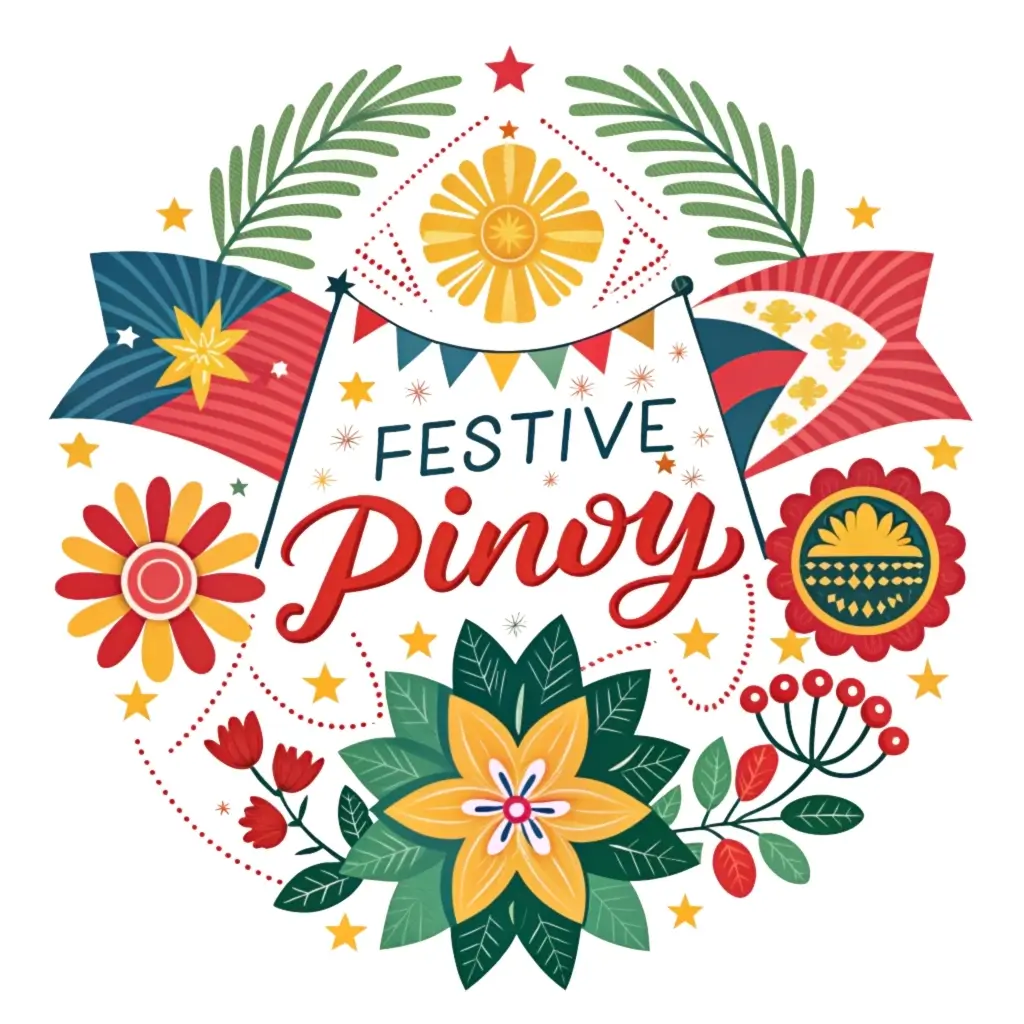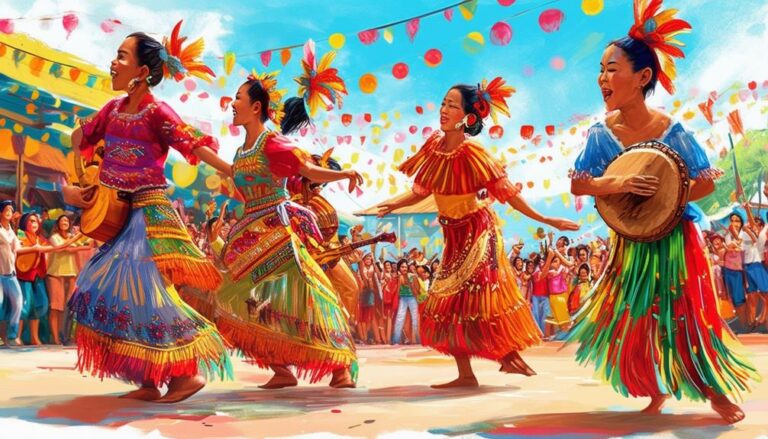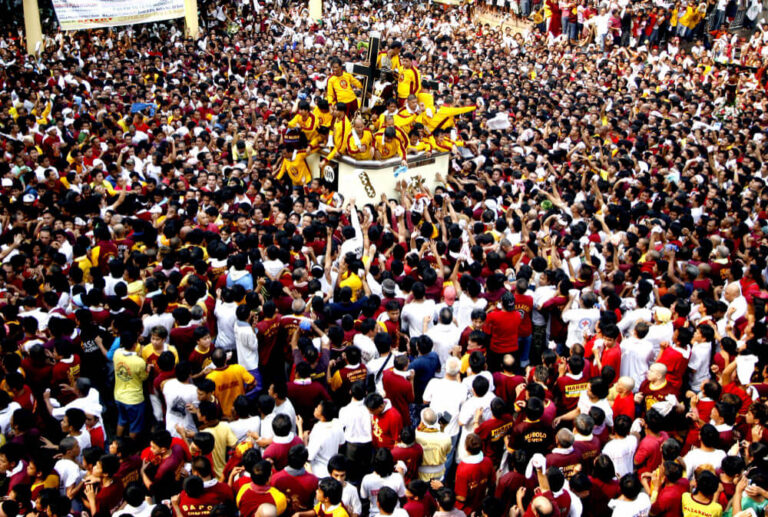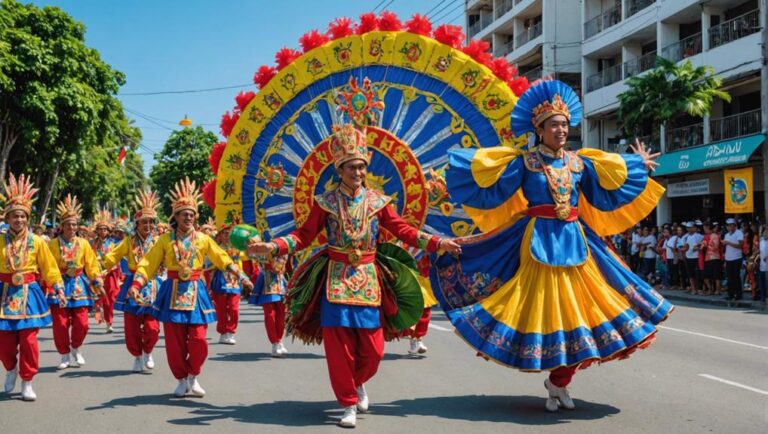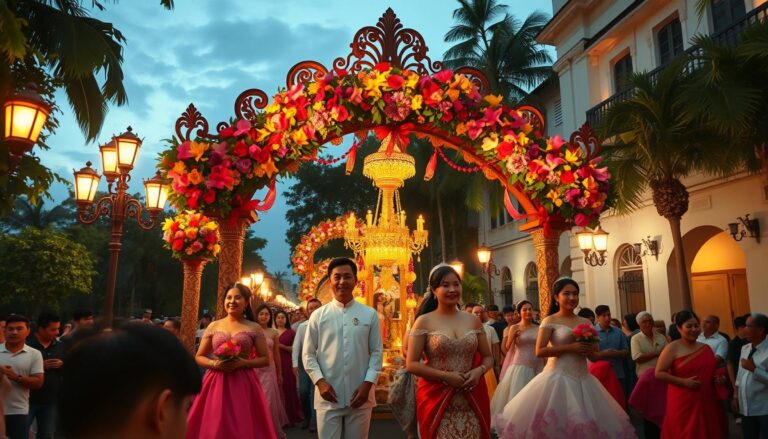Giant Lantern Festival Philippines
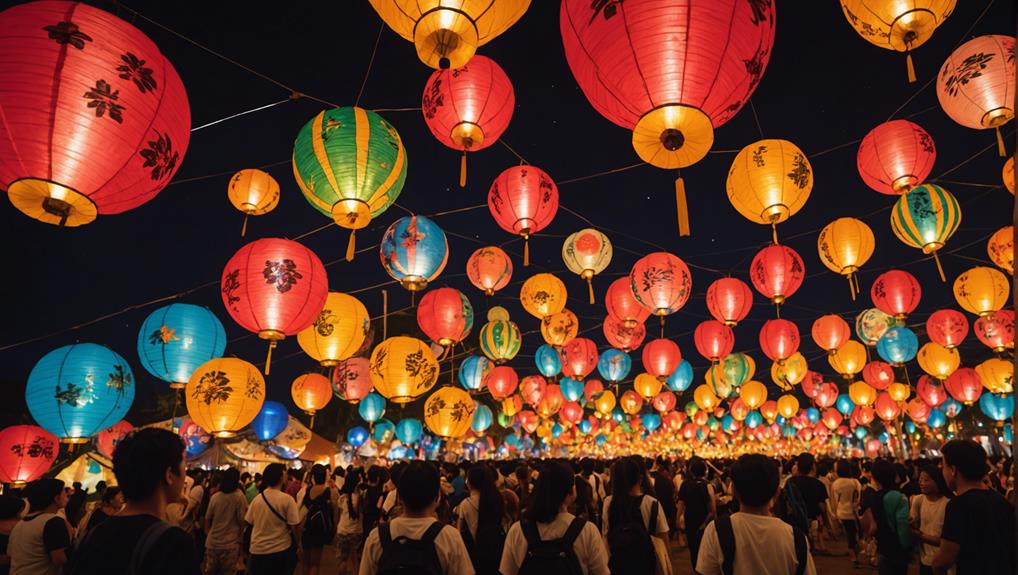
Every December, you can immerse yourself in the dazzling display of the Giant Lantern Festival in San Fernando, Pampanga. This vibrant festival began in 1904 and has evolved into a showcase of massive lanterns, some reaching up to 20 feet in diameter. These lanterns aren't just large; they symbolize hope and feature intricate designs, lit by thousands of bulbs that create mesmerizing patterns. Each year, local barangays compete, highlighting their creativity and technical skills in lantern-making, integrating traditional techniques and modern technology. The festival also serves up Pampanga's famous culinary delights, making your experience both visually and gastronomically appealing. There's much more to uncover about this luminous event.
Key Takeaways
- The Giant Lantern Festival is an annual event held in San Fernando, Pampanga, celebrating local craftsmanship and cultural heritage.
- Originally starting in 1904 in Bacolor, the festival features lanterns up to 20 feet in diameter with intricate electric-powered designs.
- The event showcases technological advancements in lantern making, integrating LED displays and computerized control systems.
- Participants from various communities compete, focusing on innovation and design detail in their lanterns.
- The festival also highlights Pampanga's culinary traditions, offering dishes like sisig and tibuk-tibuk to visitors.
Festival History and Origins
The Giant Lantern Festival, known locally as Ligligan Parul, originated in 1904 in the then capital of Pampanga, Bacolor, and later became a cherished tradition in San Fernando following the transfer of the provincial capital. This festival's historical evolution is deeply rooted in the religious traditions of the region, where devout Catholics would parade lanterns during patron saint processions to symbolize spiritual guidance and hope.
Over the years, the festival has seen remarkable artistic innovations. Initially, lanterns were simple, small, candle-lit creations. However, the introduction of electricity in 1931 transformed them into elaborate displays of light and color, increasing both their size and the complexity of their designs. This evolution reflects not only technological advancements but also a growing community collaboration. Each year, artisans and residents come together, dedicating months of labor to create these luminous masterpieces, which are now up to 20 feet in diameter and incorporate thousands of light bulbs.
Cultural significance is woven through the fabric of the festival, emblematic of Pampanga's identity as the Christmas Capital of the Philippines. The lanterns are more than festive decorations; they're a vibrant expression of local craftsmanship and community spirit. Their creative designs often blend religious symbolism with contemporary themes, reflecting societal values and communal aspirations.
The Giant Lantern Festival remains one of the most anticipated festive celebrations in the region, drawing visitors nationwide. It's a time when the community's collective effort and creative spirit are showcased, continuing to illuminate the dark December nights with messages of joy, unity, and resilience.
Venue and Participant Evolution
Reflecting on the festival's rich history, it's notable how its venues and participants have evolved over the years. Initially confined to the heart of San Fernando, the festival has moved through several venues, including Paskuhan Village and the Bren Z. Guiao Convention Center, before settling at Robinsons Starmills. This journey isn't just about geographic shifts but also mirrors the festival's growth and its increasing cultural significance.
You've seen participant growth firsthand, from its humble beginnings with a few local barangays to a vibrant competition involving multiple communities. Each year, new barangays step into the arena, like Brgy. Calulut and Brgy. Del Carmen in 2011, bringing fresh creativity and community collaboration to the forefront. This expansion is a reflection of the festival's role in fostering local pride and unity.
The integration of modern technology has been pivotal. From the simple candle-lit lanterns of the early 1900s to the dazzling LED displays controlled by advanced computer systems today, technological advancements have reshaped the festival. These innovations guarantee each lantern isn't only a spectacle of light but also of ingenuity.
Moreover, the festival isn't just a feast for the eyes but also the palate, highlighting culinary delights from Pampanga, renowned as the culinary capital of the Philippines. As you wander through the festival, you're enveloped in the scents of sisig and halo-halo, dishes that capture the essence of Kapampangan cuisine.
Each year, the Giant Lantern Festival weaves together the historical evolution and festive traditions of San Fernando, displaying a magnificent tapestry of color, light, and community spirit.
Key Competition Highlights
Diving into the vibrant competition highlights, you'll discover that each year, barangays showcase their creativity and technical prowess through stunning lantern displays. These aren't just any lanterns; they're massive, intricate masterpieces that light up the night and ignite the festive spirit throughout the region. Each lantern, often reaching up to 20 feet in diameter, is festooned with thousands of glittering lights and elaborate designs, reflecting not only the cultural significance of the festival but also the community pride of each participating barangay.
The judging criteria are rigorous, with expert opinions focusing on innovation, creativity, and the intricate details of the lanterns. This meticulous scrutiny guarantees that the winning streaks or surprise victories are well-earned, adding a thrilling element of suspense to the festival atmosphere.
Crowd favorites play a significant role in public engagement, with spectators often rallying behind their local barangays, creating a lively, competitive spirit. This public participation highlights the festival's deep-rooted legacy and points towards future developments and evolving trends in lantern design and competition.
Here's a look at some key competition highlights over recent years:
| Year | Winner | Notable Feature |
|---|---|---|
| 2017 | Brgy. Dolores | Fourth consecutive win, limited to 10,000 lights |
| 2018 | Brgy. Telabastagan | First win in five years, crowd-pleaser |
| 2019 | Brgy. Santa Lucia | Known for impactful designs, public favorite |
| 2022 | Brgy. San Juan | First-time winner, celebrated for innovation |
Each year, the Giant Lantern Festival not only celebrates the season but also showcases the evolving artistry and technical advancement of lantern making in the Philippines.
Pandemic Impact and Adaptations
COVID-19 drastically changed the traditional staging of the Giant Lantern Festival, turning the 2020 event into an exhibition rather than a competition. You witnessed how the pandemic necessitated creative adaptations, transforming challenges into opportunities for artistic innovations and deeper cultural connections within the community.
The festival's organizers swiftly pivoted to virtual celebrations, ensuring the festive spirit wasn't dimmed by the global crisis. These online showcases allowed you to enjoy the luminous spectacle from the safety of your home, fostering a sense of community resilience despite physical distances. Remote participation became the norm, and you could even cast votes for your favorite lanterns online, a digital collaboration that kept the competitive spirit alive.
Artistic innovations flourished as lantern makers experimented with designs that could be easily shared on digital platforms. The lanterns weren't just traditional symbols of the holiday season; they became beacons of hope and resilience. Through these adaptations, the festival maintained its role in strengthening cultural connections, reminding you and others of the shared heritage that binds the community together.
Despite the challenges, the Giant Lantern Festival continued to be a source of pride and joy for San Fernando. It showcased the unyielding spirit of its people, proving that even in times of crisis, creativity and unity shine brightest. As you look forward to future festivals, you carry with you the lessons learned during this unprecedented time—an affirmation of the enduring power of tradition and innovation.
Lantern Design and Technology
One can't help but marvel at the intricate technology and design behind the giant lanterns of the Giant Lantern Festival in San Fernando, Pampanga. This event showcases not just the cultural significance of the lanterns but also the technological advancements and artistic creativity that have evolved over the years. Each lantern, often spanning over 20 feet in diameter, becomes a canvas of vibrant, festive decorations, reflecting a rich tapestry of community collaboration and design evolution.
The illumination innovation in these lanterns is nothing short of spectacular. Advanced lighting techniques allow thousands of bulbs to flicker, dance, and blaze in intricate patterns, controlled by rotors and computerized systems. This tech-savvy approach to traditional lantern-making ensures each piece offers stunning visual appeal, turning the night into a dazzling spectacle of lights.
Throughout the festival, you'll notice the seamless integration of modern materials like plastics and fiberglass with traditional elements such as bamboo and capiz shells. This blend not only enhances the durability and brightness of the lanterns but also pays homage to the lantern-making heritage of Pampanga. The design evolution from simple candle-lit parols to elaborate electric-powered giants speaks volumes about the region's innovative spirit.
Moreover, the festival thrives on community collaboration. Local artisans, electricians, and designers come together, pooling their skills to craft these magnificent creations. This collective effort not only fosters a sense of unity but also ignites a shared passion for keeping their cultural heritage alive through each awe-inspiring parol that lights up the night.
Culinary Traditions of Pampanga
As you explore the Giant Lantern Festival in Pampanga, don't miss the chance to savor its rich culinary traditions.
You'll find signature dishes like sisig and tibuk-tibuk that highlight traditional cooking techniques passed down through generations.
These festive foods not only tantalize your taste buds but also offer a glimpse into the region's cultural heritage during the holiday celebrations.
Pampanga's Signature Dishes
Explore the rich culinary traditions of Pampanga, where each dish tells a story of cultural heritage and gastronomic innovation. Immerse yourself in a world where traditional recipes meet festive flavors, creating a unique array of local delicacies that reflect the region's culinary heritage.
- Sisig: Originally a method to prevent waste, this sizzling dish of chopped pig's head and liver seasoned with chili and calamansi is a culinary icon of authentic Kapampangan cuisine.
- Kare-Kare: A rich stew made from oxtail, vegetables, and peanut sauce, showcasing the regional specialty of blending savory with slightly sweet.
- Tibuk-tibuk: Made from carabao milk, this creamy pudding is a tribute to Pampanga's love for flavorful dishes and cooking traditions during festive occasions.
Traditional Cooking Techniques
Building on the rich flavors of Pampanga's signature dishes, let's now examine how traditional cooking techniques shape these culinary treasures. You'll find that the indigenous recipes of Pampanga are brought to life through age-old cooking methods, utilizing local ingredients that guarantee each dish retains its traditional flavors. The culinary heritage of this region is a proof of the culinary craftsmanship and secrets handed down through generations.
| Technique | Description |
|---|---|
| Wood Fire Cooking | Enhances flavor with smoky undertones. |
| Bamboo Steaming | Used for delicate authentic dishes. |
| Clay Pot Cooking | Slow cooking method preserving regional specialties. |
| Banana Leaf Wrapping | Imparts a unique aroma, protecting culinary secrets. |
| Salt Bed Roasting | Seals in flavors, a technique in culinary craftsmanship.
These methods are essential in creating the authentic dishes that define Pampanga's culinary scene.
Festive Food Highlights
Pampanga's festive food offerings, steeped in tradition, become the centerpiece of celebrations during the Giant Lantern Festival. You'll find yourself immersed in a world where each dish tells a story of cultural gastronomy and flavorful traditions.
Here are three must-try local delicacies:
- Sisig: Originally from Pampanga, this sizzling dish of chopped pork, seasoned with chili and lime, embodies the festive flavors of the region.
- Tibuk-Tibuk: A creamy pudding made from carabao's milk, this authentic dish showcases the culinary delights of Kapampangan traditional recipes.
- Buro: Fermented rice and fish, paired typically with steamed vegetables, offering a unique taste of regional cuisine that reflects Pampanga's tasty creations and local heritage.
Indulge in these culinary highlights and savor the authentic dishes that make the Giant Lantern Festival a feast for the senses!
Frequently Asked Questions
How Do Organizers Select Judges for the Lantern Competition?
You'd be amazed how judges are carefully chosen based on judging criteria that guarantee cultural representation, artistic background, technical expertise, and judge diversity, involving experts and community leaders with transparent selection processes.
What Are the Environmental Impacts of the Giant Lantern Festival?
You're facing issues like material waste, energy consumption, and light pollution, which disrupt wildlife and increase carbon emissions. However, recycling initiatives and sustainable materials can mitigate impacts on local ecosystems and raise community awareness.
How Do International Visitors Typically Participate or Engage With the Festival?
You'd typically engage by immersing in local culture, snapping photos, buying crafts, tasting traditional foods, dancing, enjoying music, shopping for souvenirs, joining night tours, and listening to festival stories.
Are There Any Educational Programs or Workshops Related to Lantern Making?
You can join workshops that explore cultural significance, historical roots, and artistic techniques in lantern-making, delving into material sourcing, community involvement, color symbolism, design innovation, traditional motifs, and festival stories.
What Security Measures Are Implemented During the Giant Lantern Festival?
You'll find robust security measures including crowd control, police presence, and surveillance cameras. Emergency exits, first aid stations, and incident reporting guarantee safety. Security training, bag checks, and public announcements further enhance security.
Conclusion
As you immerse yourself in the Giant Lantern Festival, you'll marvel at more than just the lights. From the rich history rooted in 1904 craftsmanship to the state-of-the-art technology driving today's 20-foot parols, every detail reflects Pampanga's spirit.
Despite challenges like the pandemic, the festival has adapted, ensuring the tradition thrives. End your visit with a taste of local cuisine, celebrating a sensory feast that truly encapsulates the vibrant culture of the Philippines. During this time, guests can indulge in some of the most famous dishes in Filipino cuisine such as adobo, sinigang, and lechon. These flavorful and aromatic dishes are an essential part of the sinulog festival celebration, representing the rich and diverse flavors of the region. The sinulog festival celebration is not just a visual spectacle, but also a culinary journey that immerses visitors in the heart of Filipino tradition. In addition to the delicious food, the Sinulog Festival also showcases traditional dance and music, with colorful street parades and lively performances. This immersive experience allows visitors to fully appreciate the rich tapestry of Filipino festival traditions, from the culinary delights to the vibrant cultural expressions. The Sinulog Festival truly embodies the spirit of community and celebration, making it a must-visit event for anyone wanting to experience the warmth and hospitality of the Filipino people.
